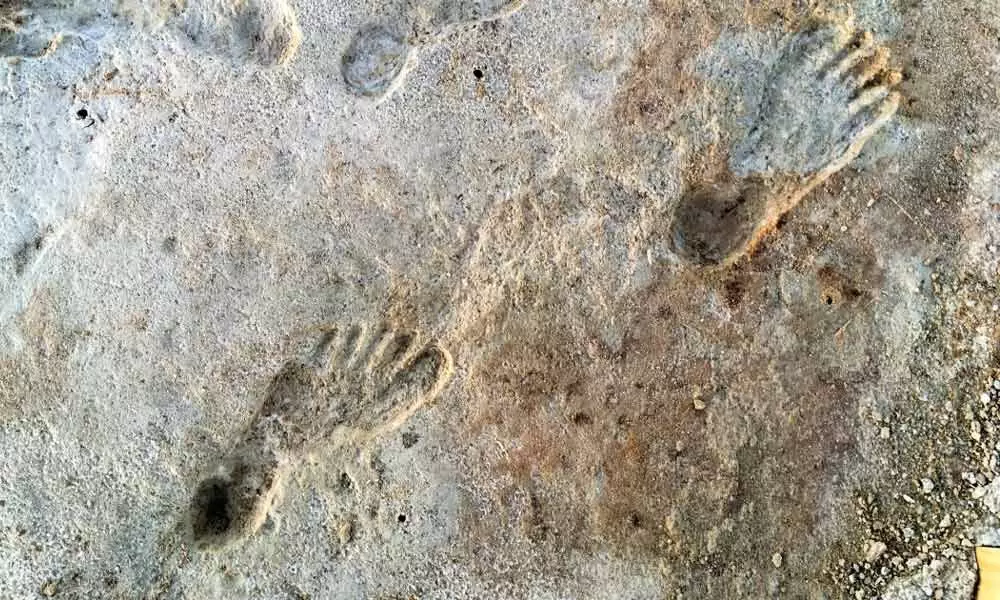Live
- A Soulful Celebration of Global Music
- Brahmin Community delegation felicitates CM Saini
- Allu Arjun Visits Chiranjeevi’s House for Lunch Meet
- Toyota organising TG Grameena Mahotsav
- Special rituals conducted at Maramma Temple
- Siddaramaiah has special love for Muslims: BJP
- We can’t afford spending less than 6% of GDP on healthcare
- Guinness World Record for continuous Hanuman Chalisa chanting
- REMOTE TRIBAL AREA TO GET NEW BRIDGE
- Dr LB College, Woxsen teams win in Climate Tank Accelerator event
Just In
Early historic Known Evidence of Humans in North America Is Found In Fossil Footprints

Hans News Service | 24 Sept 2021 3:45 PM IST

x
Early historic Known Evidence of Humans in North America Is Found In Fossil Footprints
Highlights
- Humans arrived in North America 7,000 years before archaeologists anticipated.
- Fossil footprints discovered on the shore of an ancient lake bed in White Sands National Park, New Mexico, are the oldest yet discovered in North America, dating back 23,000 years.
A remarkable discovery shows that humans arrived in North America 7,000 years before archaeologists anticipated.
Fossil footprints discovered on the shore of an ancient lake bed in White Sands National Park, New Mexico, are the oldest yet discovered in North America, dating back 23,000 years. Because of the timing, humans occupied southern sections of the continent during the final ice age, which contradicts our earlier assumptions about when and how they travelled south.
The prior theory was that during the last ice age, between 26,500 and 19,000 years ago, the first humans to inhabit North America crossed a land bridge that existed between modern-day Siberia and Alaska.
According to this argument, they would have had to stay in the Arctic because further south would have been difficult due to ice sheets covering Canada. Then, between 16,000 and 13,500 years ago, as these glaciers retreated, the migration to South America began.
Sally Reynolds, a paleoecologist at Bournemouth University in England and co-author of the new study, told Insider that the new discovery definitively places humans in North America at a time when the ice sheet curtains were very securely closed.
So, according to Reynolds, humans travelled south in waves, one of which occurred before the last ice age. It's possible that those early people sailed down the Pacific coast.
After the ice receded, more came down, Reynolds explained.
The discovery was published in the journal Science on Thursday, along with neighbouring mammoth, dire wolf, and giant ground sloth tracks — all of which were prey for ancient people.
Between 21,000 and 23,000 years ago, Reynolds' team discovered 60 human footprints. The researchers dated microscopic seeds from an aquatic plant found in layers of lake sediment that sandwiched the impressions to determine their age.
The footprints have surpassed a 15,600-year-old footprint discovered in Chile a decade ago as the oldest in the Americas.
The team discovered that the majority of the tracks belonged to teenagers and children, presumably indicating that the children were playing while the adults hunted and gathered. Prior to this discovery, the earliest estimate for when humans first arrived in North America was 16,000 years ago, according to Reynolds.
A cache of stone tools and artefacts discovered in a remote Mexican cave is the only evidence that people may have arrived earlier. The mud encasing the items was estimated to be 32,000 years old by archaeologists, but that isn't a reliable figure, according to Reynolds. Over time, artefacts can move up and down through sediment layers. Footprints, on the other hand, are imprinted in the landscape,
According to Reynolds, it's still unclear how humans got to the White Sands site, however there are a few prominent possibilities.
They may have migrated along the west coast via an ice-free land corridor, according to one theory. Another theory claims they arrived via water, probably sailing from modern-day Russia or Japan and then following the Pacific Coast south.
Reynolds believes it's also feasible that our forefathers traversed the continent, sailed down the Atlantic coast, and then trekked to New Mexico.
According to her, there's a lingering question mark about the role of their seafaring abilities. This isn't the first time the White Sands site has yielded a significant find. It has much, far more importance than the date of these new footprints, Reynolds said.
Her team discovered a second collection of human and animal tracks at the site three years earlier, dating back to around 15,500 years ago. Those traces revealed a massive predator-prey battle: A gigantic sloth was being pursued by a human.
The sloth is obviously not loving it, Reynolds said, adding, since the human was strolling close behind it. 12,000 years ago, giant ground sloths became extinct.
At the same time, up to 90% of all large-bodied species on the planet went extinct, including mastodons, prehistoric horses, and ancient enormous armadillos.
Given that the mass extinction occurred within a few millennia of their arrival, many archaeologists believe that early people in the Americas played a significant part in it.

Next Story
More Stories
ADVERTISEMENT
© 2024 Hyderabad Media House Limited/The Hans India. All rights reserved. Powered by hocalwire.com






